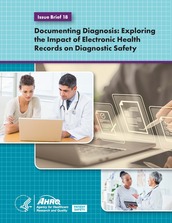July 23, 2024, Issue #922 AHRQ Stats: Disorders Commonly Associated With ReadmissionSepsis, heart failure and complications from diabetes were the most common conditions associated with hospital readmissions in 2020, accounting for nearly 20 percent of all adult readmissions. (Source: AHRQ Healthcare Cost and Utilization Project Statistical Brief #307: Clinical Conditions with Frequent, Costly Hospital Readmissions by Payer, 2020.) Today's Headlines:  An AHRQ-funded study published in Physiological Measurement concluded that a predictive analytics tool called CoMET, developed five years before the COVID-19 pandemic, was very accurate in predicting which patients declined in the hospital during the pandemic. Tested in a randomized controlled trial with more than 10,000 patient visits, the tool accurately predicted significant health declines, primarily due to respiratory issues. The study found that the tool’s predictions remained accurate despite changes in clinical practices over time, including during the pandemic. The analysis underscores the importance of real-world validation for predictive models, researchers concluded. Access the abstract. An AHRQ-funded study published in Physiological Measurement concluded that a predictive analytics tool called CoMET, developed five years before the COVID-19 pandemic, was very accurate in predicting which patients declined in the hospital during the pandemic. Tested in a randomized controlled trial with more than 10,000 patient visits, the tool accurately predicted significant health declines, primarily due to respiratory issues. The study found that the tool’s predictions remained accurate despite changes in clinical practices over time, including during the pandemic. The analysis underscores the importance of real-world validation for predictive models, researchers concluded. Access the abstract.
|
 Electronic health records are essential in modern healthcare, centralizing patient data and supporting clinical decision-making and continuity of care. A new issue brief explores the history of documentation legislation, outstanding challenges and best practices to improve documentation, and identifies future developments and opportunities for improvement. Access the issue brief and other AHRQ publications on diagnostic safety. Electronic health records are essential in modern healthcare, centralizing patient data and supporting clinical decision-making and continuity of care. A new issue brief explores the history of documentation legislation, outstanding challenges and best practices to improve documentation, and identifies future developments and opportunities for improvement. Access the issue brief and other AHRQ publications on diagnostic safety.
|
 Despite widespread reports of overcrowding, hospital emergency department (ED) visits were lower than pre-pandemic levels by the end of the COVID-19 public health emergency, a new AHRQ-funded study found. In the study, published in Health Affairs, researchers reviewed records of fee-for-service Medicare beneficiaries and found that ED visits were 25 percent lower than pre-pandemic levels by the end of the public health emergency study. However, hospitals experienced longer patient stays and higher overall capacity, which did not stabilize until 2022. In addition, discharges to postacute-care facilities dropped initially, then leveled off slightly below baseline. Researchers said the data suggest that overcrowding was due more to prolonged hospital stays and fewer available post-acute care beds rather than a surge in ED visits. Access the abstract. Despite widespread reports of overcrowding, hospital emergency department (ED) visits were lower than pre-pandemic levels by the end of the COVID-19 public health emergency, a new AHRQ-funded study found. In the study, published in Health Affairs, researchers reviewed records of fee-for-service Medicare beneficiaries and found that ED visits were 25 percent lower than pre-pandemic levels by the end of the public health emergency study. However, hospitals experienced longer patient stays and higher overall capacity, which did not stabilize until 2022. In addition, discharges to postacute-care facilities dropped initially, then leveled off slightly below baseline. Researchers said the data suggest that overcrowding was due more to prolonged hospital stays and fewer available post-acute care beds rather than a surge in ED visits. Access the abstract.
|
A Notice of Funding Opportunity from AHRQ seeks grant applications for developing and testing patient-centered clinical decision support (CDS) strategies in real-world settings. In contrast to traditional clinician-facing CDS, patient-centered CDS facilitates the active involvement of patients and caregivers in healthcare decision-making. Through the AHRQ-funded Patient Centered Outcomes Research CDS Initiative, patient-centered CDS resources are available for researchers to further build upon. Research is needed to understand how to make clinician-facing CDS more patient centered, while also engaging patients, families and caregivers in designing and implementing these tools. AHRQ’s Patient Safety Network (PSNet) highlights journal articles, books and tools related to patient safety. Articles featured this week include:
Review additional new publications in PSNet’s current issue, including recent cases and commentaries and AHRQ’s WebM&M (Morbidity and Mortality Rounds on the Web). | AHRQ in the Professional Literature Using 42 CFR part 2 revisions to integrate substance use disorder treatment information into electronic health records at a safety net health system. Tillman AR, Bacon E, Bender B, et al. Addict Sci Clin Pract. 2024 Jun 7;19(1):48. Access the abstract on PubMed®.
Clinical outcomes of female external urine wicking devices as alternatives to indwelling catheters: a systematic review and meta-analysis. Pryor N, Wang J, Young J, et al. Infect Control Hosp Epidemiol. 2024 May 6:1-9. [Epub ahead of print.] Access the abstract on PubMed®.
Acceptance of automated social risk scoring in the emergency department: clinician, staff, and patient perspectives. Mazurenko O, Hirsh AT, Harle CA, et al. West J Emerg Med. 2024 Jul;25(4):614-23. Access the abstract on PubMed®.
Geographic and physician-level variation in the use of hypofractionated radiation therapy for breast cancer in the U.S.: a cross-classified multilevel analysis. Sun Y, Saulsberry L, Liao C, et al. Adv Radiat Oncol. 2024 Jun;9(6):101487. Epub 2024 Mar 12. Access the abstract on PubMed®.
Supporting ColoREctal Equitable Navigation (SCREEN): a protocol for a stepped-wedge cluster randomized trial for patient navigation in primary care. Rivera Rivera JN, AuBuchon KE, Schubel LC, et al. Implement Sci Commun. 2024 Jun 3;5(1):60. Access the abstract on PubMed®.
Safety of primary nasotracheal intubation in the pediatric intensive care unit (PICU). Ducharme-Crevier L, Furlong-Dillard J, Jung P, et al. Intensive Care Med Paediatr Neonatal. 2024;2(1):7. Epub 2024 Feb 23. Access the abstract on PubMed®.
Which older adults are at highest risk of prescribing cascades? A national study of the gabapentinoid-loop diuretic cascade. Growdon ME, Jing B, Morris EJ, et al. J Am Geriatr Soc. 2024 Jun;72(6):1728-40. Epub 2024 Mar 28. Access the abstract on PubMed®.
Measuring primary care spending in the US by state. Cohen DJ, Totten AM, Phillips RL, Jr., et al. JAMA Health Forum. 2024 May 3;5(5):e240913. Access the abstract on PubMed®. Contact Information
For comments or questions about AHRQ News Now, contact Bruce Seeman, (301) 427-1998 or Bruce.Seeman@ahrq.hhs.gov. |